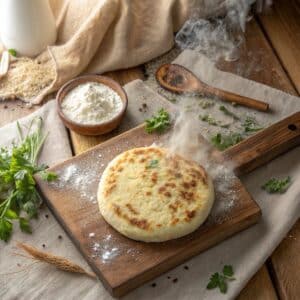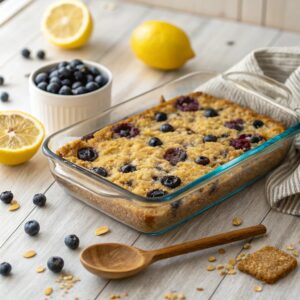Cooking a delicious meal doesn’t have to mean a mountain of dishes in the sink. If you’re looking for a simple, time-saving solution that doesn’t skimp on flavor, then One-Pot Pasta is the answer you’ve been waiting for. With just a handful of ingredients and one pot, you can create a hearty, mouthwatering pasta dish that’s perfect for busy weeknights or lazy weekends. This guide will cover everything you need to know about One-Pot Pasta, from essential ingredients and cooking techniques to handy tips, FAQs, and flavorful variations.
Learn more about how One-Pot Pasta can transform your kitchen routine in this comprehensive guide—let’s get started!
Understanding the One-Pot Pasta Concept
One-Pot Pasta is a cooking method where you prepare the entire pasta dish—pasta, sauce, and all—in a single pot. Unlike traditional methods that involve boiling pasta separately and then combining it with sauce, the one-pot technique allows the pasta to cook directly in the sauce and water. This means fewer dishes to wash, less cooking time, and a richer, more cohesive flavor because the starch from the pasta helps to thicken the sauce naturally.
The beauty of this method is in its simplicity. Just toss your dry pasta, veggies, aromatics like garlic and onions, sauce, and water into the pot, bring it to a boil, stir occasionally, and voilà! A flavorful pasta dish is ready in less than 30 minutes.
Print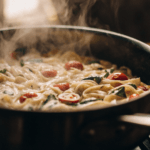
One-Pot Pasta
- Total Time: 24 minutes
Description
One-Pot Pasta is the ultimate easy dinner hack! Discover the best 9-step guide, tips, and variations for a no-fuss, flavor-packed meal.
Ingredients
8 oz pasta, 8 oz tomatoes, 2 garlic cloves, ½ onion, 1 zucchini, 3 oz mushrooms, ½ tsp red pepper flakes, ½ tsp kosher salt, 1¼ cup sauce, 2½ cups water, 3 oz spinach
Instructions
Combine all ingredients (except spinach) in a large pot, bring to a boil, stir every 2 minutes, cook 10–14 minutes, stir in spinach, serve warm.
Notes
Best with short pasta shapes; gluten-free options work.
- Prep Time: 10 minutes
- Cook Time: 14 minutes
Table of Contents
Benefits of Cooking Pasta in One Pot
The benefits of cooking One-Pot Pasta go beyond convenience. First, the technique saves time and energy—there’s no need to boil water in a separate pot or drain the pasta afterward. Second, One-Pot Pasta often results in a creamier sauce thanks to the starch released during cooking. Third, it’s a fantastic way to infuse flavor throughout the dish, as all ingredients cook together and mingle in one pot.
Here’s a quick table highlighting why One-Pot Pasta is a game changer:
| Benefit | Traditional Pasta | One-Pot Pasta |
|---|---|---|
| Separate pots required? | Yes | No |
| Cooking time? | Longer | Faster |
| Flavor distribution? | Less even | Well blended |
| Cleanup? | More dishes | Minimal dishes |
| Sauce consistency? | Can vary | Naturally creamy |
If you’re looking for a kitchen hack that combines ease, flavor, and minimal cleanup, One-Pot Pasta is a must-try.

Core Ingredients for a Flavorful Dish
To make a satisfying One-Pot Pasta, you don’t need a fancy pantry—just a few everyday ingredients that pack a punch of flavor. Here’s the essential list:
- 8 ounces dry pasta – Use gluten-free or regular pasta. Short shapes like penne, shells, or macaroni work best.
- 8 ounces grape or cherry tomatoes, halved – These add a burst of sweetness and color.
- 2 garlic cloves, minced – For that rich, savory base.
- 1/2 yellow onion, thinly sliced – Provides a mild, aromatic flavor.
- 1 small zucchini, chopped and quartered – Adds freshness and texture.
- 3 oz cremini mushrooms, sliced – Brings an earthy, umami depth.
- 1/2 teaspoon red pepper flakes (optional) – For a hint of heat.
- 1/2 teaspoon kosher salt – Enhances all the flavors.
- 1 1/4 cup pasta sauce of choice – Use your favorite marinara or tomato-based sauce.
- 2 1/2 cups water – The liquid for cooking the pasta and creating the sauce.
- 3 ounces fresh spinach – Stirred in at the end for a pop of green and nutrients.
These ingredients work together to create a balanced, flavorful dish that’s hearty, wholesome, and comforting.
Substitution Ideas for Different Tastes
One of the best things about One-Pot Pasta is its flexibility. If you’re feeling creative or want to tweak the recipe to suit your taste buds, here are some simple substitutions:
| Ingredient | Swap With | Flavor/Texture Change |
|---|---|---|
| Zucchini | Bell peppers, broccoli, or peas | Different textures, color variety |
| Cremini mushrooms | Portobello, button, or shiitake | Varies the earthiness and depth |
| Pasta sauce | Pesto, Alfredo, or pink sauce | Brings new flavor profiles |
| Spinach | Kale or arugula | Slightly different leafy greens |
| Gluten-free pasta | Regular pasta or whole-wheat pasta | Adjust for dietary needs and taste |
Feel free to adjust the spice level by adding more or less red pepper flakes, or throw in some fresh herbs like basil or parsley for a final flourish.
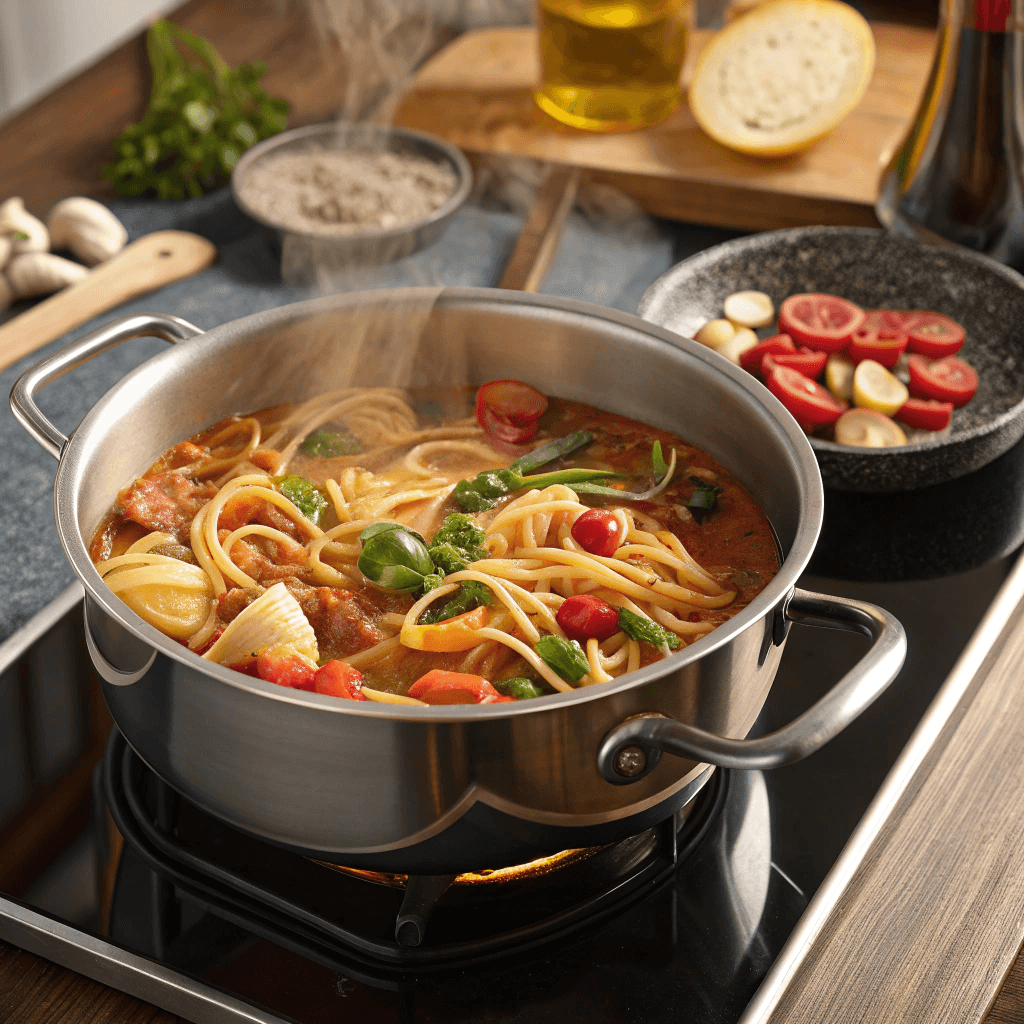
Preparation: Chopping, Slicing, and Dicing
Before you turn on the stove, a little prep goes a long way to making your One-Pot Pasta smooth and easy. Here’s how to get started:
- Halve the grape or cherry tomatoes – This helps them cook down faster, releasing their sweet juices into the sauce.
- Mince the garlic cloves – Finely chopping allows the flavor to spread evenly.
- Thinly slice the onion – Keep the slices thin so they soften quickly during cooking.
- Chop and quarter the zucchini – This ensures it cooks evenly and blends into the dish.
- Slice the mushrooms – Uniform slices help them cook at the same rate.
Once you’ve got everything ready, it’s time to cook!
Cooking Process: Boiling, Stirring, and Finishing
Here’s the simple process for making a perfect One-Pot Pasta:
- Add everything (except spinach) to the pot: Toss in the dry pasta, prepped vegetables, garlic, onion, pasta sauce, water, salt, and red pepper flakes. Mix it all together.
- Bring the pot to a boil over high heat: Once it reaches a rolling boil, give it a good stir to ensure nothing sticks to the bottom.
- Reduce the heat to medium-low: Let it simmer gently, stirring every 2 minutes. This prevents sticking and ensures even cooking.
- Cook for 10–14 minutes: Keep an eye on the pasta’s doneness—different shapes and brands cook at different rates. Check for al dente texture by tasting at the minimum cook time listed on the package.
- Add the spinach last: Turn off the heat, stir in the fresh spinach, and let it wilt into the dish.
- Serve and enjoy: Spoon into bowls and garnish as you like—try fresh herbs, grated cheese, or a drizzle of olive oil.
Here’s a quick table to keep the process clear:
| Step | Action | Timing/Tip |
|---|---|---|
| Prep ingredients | Slice, chop, mince | Before starting the cooking process |
| Combine in pot | Pasta, veggies, sauce, water | Mix thoroughly before boiling |
| Boil | High heat | Stir every 2 minutes |
| Simmer | Medium-low heat | Cook 10–14 minutes, check for doneness |
| Finish with spinach | Add off-heat | Stir in and let wilt before serving |
Don’t miss our Zesty Lemon Garlic Pasta recipe for another easy and flavorful pasta dish!
What is the Ideal Ratio of Pasta to Water in One-Pot Cooking?
Getting the right ratio of pasta to water is key for achieving that perfectly cooked, creamy One-Pot Pasta. A general rule of thumb is to use about 2½ cups of water for every 8 ounces of dry pasta. This allows the pasta to cook through while absorbing the liquid and releasing starches that naturally thicken the sauce.
Here’s a quick breakdown:
| Pasta | Water |
|---|---|
| 8 oz dry pasta | 2½ cups water |
| 16 oz pasta | 5 cups water |
But remember, this ratio can vary slightly depending on the type of pasta you use:
- Short pasta shapes like penne, shells, or macaroni tend to absorb less water.
- Whole wheat or gluten-free pasta may require slightly more water, so check for doneness a minute or two earlier.
- Long pasta shapes like spaghetti or fettuccine are trickier in a one-pot method and might need a bit more stirring to prevent sticking.
For best results, always monitor the pasta’s doneness by tasting it—don’t just rely on the clock!
Adjusting Ratios for Different Pasta Shapes
Different pasta shapes can change how much water you need. Here’s a handy guide:
| Pasta Type | Suggested Water Ratio |
|---|---|
| Short pasta (penne, shells) | 2½ cups water per 8 oz pasta |
| Long pasta (spaghetti) | 3 cups water per 8 oz pasta |
| Gluten-free pasta | 2¾ cups water per 8 oz pasta |
| Whole wheat pasta | 2¾ cups water per 8 oz pasta |
The idea is to have just enough water to cook the pasta fully while allowing the sauce to thicken. If it’s looking too dry, add a splash of hot water during cooking. If it’s too soupy, cook it a bit longer uncovered to reduce.
Looking for inspiration? Try this cozy Rustic Creamy Tomato Pasta recipe that nails the one-pot ratio every time!
The Story Behind the “Marry Me Pasta” Name
Ever heard someone say a dish is so good it’ll make you want to propose? That’s exactly where the nickname “Marry Me Pasta” comes from. The term first popped up when food bloggers started sharing recipes for creamy, tomato-based pasta dishes so rich, comforting, and downright delicious that they jokingly suggested it could win someone’s heart—hence the name!
The idea is simple: a dish that’s that good, it could spark a proposal. It’s a little cheeky, a lot romantic, and it speaks to the universal appeal of a well-made pasta dish that combines simplicity with deep, layered flavors.
This nickname isn’t limited to one recipe—it’s often associated with dishes featuring ingredients like sun-dried tomatoes, garlic, cream, and Parmesan. But honestly, any One-Pot Pasta that hits the right balance of flavors, textures, and comfort can earn the title of “Marry Me Pasta.”
What Makes Marry Me Pasta Special?
Marry Me Pasta isn’t just about a catchy name. Here’s why people keep coming back for more:
- Bold Flavors: The combo of tomatoes, garlic, and creamy sauce makes every bite pop.
- Easy to Make: Like our One-Pot Pasta method, it’s a simple process—just one pot, a handful of ingredients, and a little love.
- Customizable: You can add protein (like chicken or shrimp), play with herbs (basil, thyme, oregano), or tweak the spice level.
- Comfort Food Vibes: It’s cozy, satisfying, and perfect for sharing with loved ones—or for treating yourself on a solo night in!
Here’s a quick look at why it’s a must-try:
| Reasons People Love It | Details |
|---|---|
| Flavor | Rich, savory, slightly sweet, creamy |
| Ease of Cooking | One pot, simple steps, minimal dishes |
| Flexibility | Adaptable to dietary needs and tastes |
| Crowd-Pleaser Factor | Appeals to both casual cooks and foodies alike |
Don’t miss our Hearty Creamy Garlic Chicken recipe for another dish that might just earn the “Marry Me” nickname at your table!
Common Questions About One-Pot Pasta Cooking
Let’s face it—many home cooks wonder if the One-Pot Pasta method is too good to be true. Can pasta really cook properly when simmered with everything else in one pot? The answer is yes! The key lies in balancing liquid, timing, and stirring.
When pasta cooks, it releases starch, which thickens the cooking liquid and creates a creamy, cohesive sauce. With a little attention—mainly stirring every few minutes to prevent sticking—you’ll get perfectly cooked pasta and a flavorful sauce all in one.
Still skeptical? Let’s bust a few common myths:
- Myth 1: Pasta will be mushy. → Fact: If you stir regularly and monitor doneness, you can achieve a perfect al dente texture.
- Myth 2: Sauce will be too thin or too thick. → Fact: Adjust liquid amounts and cook times for your preferred consistency.
- Myth 3: The dish lacks flavor. → Fact: With garlic, onions, veggies, and sauce cooking together, flavors build beautifully.
The secret is to check the pasta often, taste as you go, and adjust as needed.
Tips to Avoid Sticky or Mushy Pasta
Want foolproof One-Pot Pasta every time? Here are pro tips to keep your dish from turning into a sticky mess:
- Stir every 2–3 minutes: This keeps the pasta from sticking to the bottom and ensures even cooking.
- Use enough liquid: Follow the recommended ratios (2½ cups water per 8 oz pasta) to avoid undercooked or overly thick pasta.
- Don’t overcook: Check pasta doneness 2 minutes before the package’s suggested time—better to undercook slightly, as it will continue to soften after heat is turned off.
- Use short pasta shapes: Penne, rotini, shells, or macaroni work best in one-pot recipes. Long noodles may clump unless stirred frequently.
- Fold in greens last: Spinach and other delicate veggies should be added off-heat to preserve their color and texture.
For another flavor-packed one-pot idea, check out this Savory Tuscan Chicken Pasta recipe that uses similar techniques.
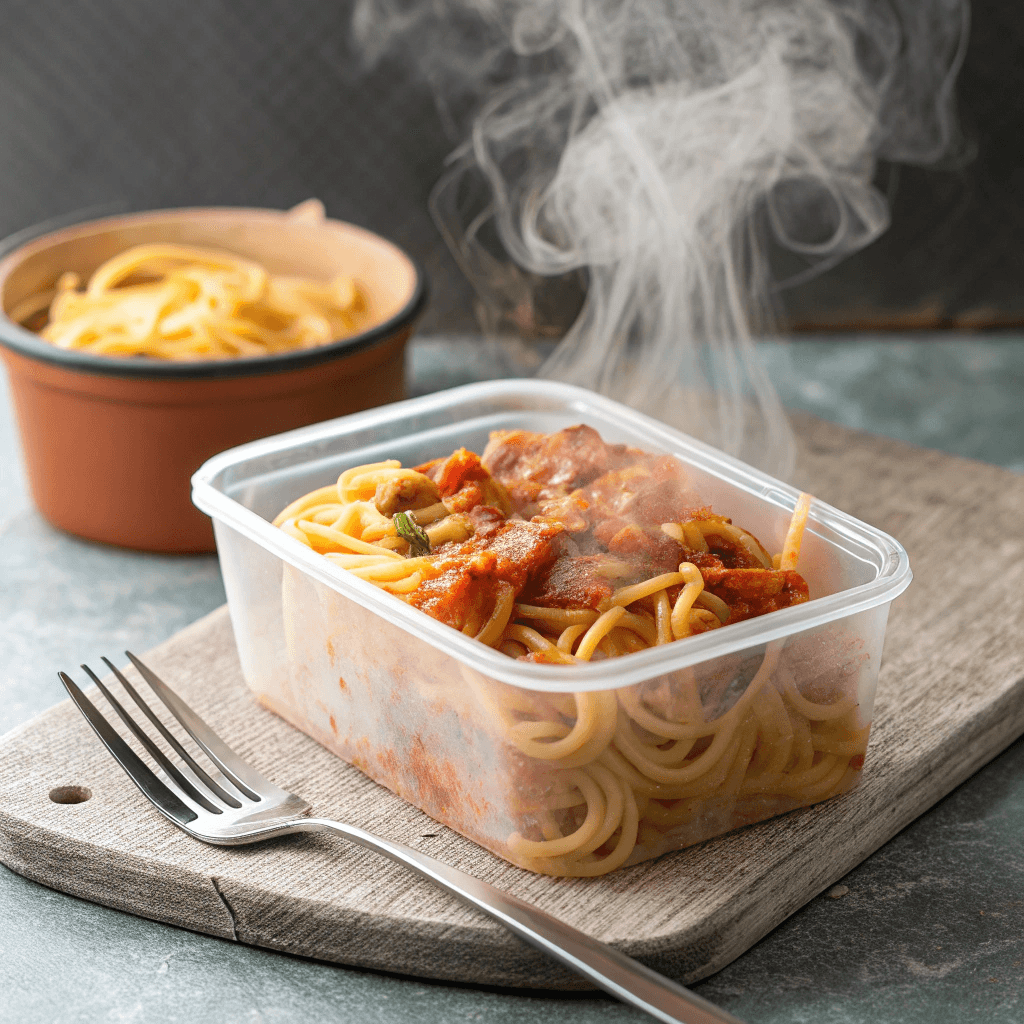
Guidelines for Single-Serving Pasta Cooking
Ever wondered how much pasta is enough for just one person? You’re not alone. When it comes to One-Pot Pasta, the typical rule is 2 ounces of dry pasta per person. That might sound small, but once you add in the sauce, veggies, and any toppings, it’s a satisfying, balanced portion.
Here’s a simple chart to help you measure:
| Number of People | Dry Pasta Amount |
|---|---|
| 1 | 2 oz |
| 2 | 4 oz |
| 4 | 8 oz (half a box) |
| 6 | 12 oz |
For a single serving of One-Pot Pasta, combine 2 oz dry pasta with roughly ¾ cup water and ½ cup sauce, plus a small handful of veggies. Adjust the liquid slightly based on the pasta shape and sauce thickness.
Scaling Up for Families or Meal Prep
Cooking for a family or prepping meals for the week? No problem! The beauty of One-Pot Pasta is how easily you can scale the recipe:
- For 4 servings: Use 8 oz pasta, 2½ cups water, and 1¼ cup sauce (the amounts from the original recipe).
- For 6 servings: Use 12 oz pasta, 3¾ cups water, and about 2 cups sauce.
- For 8 servings: Use a full pound (16 oz) pasta, 5 cups water, and 2½ cups sauce.
Always adjust based on the type of pasta and ingredients you add. And remember—leftovers can last in the fridge for up to 5 days, making One-Pot Pasta a perfect option for meal prep.
Don’t miss our Quick and Easy Shrimp Pasta recipe for another great single-pot meal idea!
Flavor Boosters: Herbs, Spices, and Sauces
One-Pot Pasta is a blank canvas, ready for you to customize with your favorite flavors. Here are some simple, delicious ways to elevate your dish:
- Fresh herbs like basil, parsley, or thyme add a bright, flavorful finish—stir them in at the end for a burst of freshness.
- Garlic and onion powder: Add a pinch during cooking to intensify the flavor.
- Lemon zest or juice: A squeeze of lemon over the finished dish adds freshness.
- Parmesan or pecorino cheese: Stir in grated cheese for a savory, salty kick.
- Chili flakes or hot sauce: For those who like it spicy, a little heat goes a long way.
- Pesto drizzle: Swirl in a spoonful of pesto for a herby, nutty twist.
Here’s a quick table with ideas:
| Add-On | Effect |
|---|---|
| Basil/parsley | Fresh, herbaceous finish |
| Lemon zest | Bright, tangy balance |
| Red pepper flakes | Spicy heat |
| Pesto | Rich, herby flavor |
| Grated Parmesan | Creamy, umami depth |
Adding Proteins and Seasonal Vegetables
Want to make your One-Pot Pasta even heartier? Here’s how to amp it up with protein and seasonal produce:
- Chicken: Dice and brown before adding pasta; adds lean protein.
- Shrimp: Toss in near the end of cooking for a fast-cooking protein.
- Tofu or chickpeas: Plant-based options that work well for vegetarians.
- Roasted red peppers: Stir in for smoky-sweet flavor.
- Butternut squash or pumpkin: Perfect for a fall twist.
- Asparagus or peas: Great for spring-inspired pasta dishes.
Try this idea: For a protein-packed twist, check out our Chicken Pesto Pasta Bake recipe—it’s a family favorite!
How to Store Leftover One-Pot Pasta
If you find yourself with extra One-Pot Pasta (lucky you!), storing it properly will help maintain the flavor and texture. Here’s how:
- Cool completely before transferring to an airtight container. This step prevents condensation, keeping the pasta from getting soggy.
- Refrigerate within 2 hours to ensure food safety.
- Keep it refrigerated for up to 5 days.
Want to freeze it? Technically, you can freeze One-Pot Pasta, but keep in mind the texture may change when thawed.If you plan to freeze the salad, cook the pasta slightly underdone to prevent it from becoming mushy when reheated.
Reheating Tips to Keep the Texture Just Right
Nobody wants dry, clumpy pasta. Follow these tips to bring your leftovers back to life:
- Reheat pasta salad on the stovetop: by adding a splash of water, milk, or broth to loosen the dressing as it warms. Stir occasionally over medium-low heat until heated through.
- Microwave method: Place the pasta in a microwave-safe dish, add a tablespoon of liquid, cover loosely, and heat in 1-minute intervals, stirring in between, until warm.
- Avoid overcooking: Heat until just warmed through to maintain the pasta’s bite.
Here’s a quick reference chart for storage:
| Storage Method | How Long It Lasts |
|---|---|
| Fridge (airtight container) | Up to 5 days |
| Freezer (optional) | Up to 2 months (texture may change) |
Leftovers are great for quick lunches or dinners! Pair with a simple salad or a slice of crusty bread for a complete meal.
Discover more easy meal prep ideas with our Easy Make-Ahead Breakfast Casserole recipe—it’s a lifesaver on busy mornings!
Conclusion
One-Pot Pasta is more than just a recipe—it’s a kitchen hack that saves time, reduces dishes, and makes flavorful meals with ease. By mastering the art of combining the right ingredients, keeping an eye on the pasta-to-water ratio, and stirring regularly, you can create a dish that’s creamy, satisfying, and full of flavor in under 30 minutes.
Whether you’re trying a basic recipe, experimenting with Marry Me Pasta vibes, or adding your own protein-packed twist, One-Pot Pasta is a reliable go-to that works for busy weeknights, family dinners, or meal prep days.
So what’s stopping you? Grab your favorite pot, gather your ingredients, and start cooking! Don’t forget to share your creations and tag us—we’d love to see what you make.
For more inspiration, check out our Savory Vegetable Quinoa Bowl for another easy, healthy meal idea!
for more recipes follow me in facebook in pinterest.
FAQ Section
What is the ratio of pasta to water for one-pot pasta?
For one-pot pasta, the standard ratio is 2½ cups of water for every 8 ounces of dry pasta. This ensures the pasta cooks evenly, absorbs enough liquid, and the sauce thickens perfectly. Depending on pasta type (whole wheat, gluten-free, or traditional), you might adjust slightly by adding an extra splash of water if the dish seems too dry.
Why is it called “Marry Me Pasta”?
The name “Marry Me Pasta” comes from the idea that the dish is so delicious, it could inspire someone to propose marriage! It’s often used to describe creamy, tomato-based pasta recipes that are rich, comforting, and full of bold flavors—so irresistible that it might just win hearts.
Do one-pot pasta work?
Yes, absolutely! One-pot pasta is a proven method that works by using the starch from the pasta to thicken the sauce as everything cooks together. It saves time, reduces cleanup, and blends flavors beautifully. Just be sure to stir regularly and check the pasta for doneness.
How much pasta do I need to boil for one person?
For a single serving, the general guideline is 2 ounces of dry pasta per person. This might not look like much, but once cooked with sauce and other ingredients, it turns into a hearty meal that satisfies. For bigger appetites or more generous portions, you can increase to 3 ounces per person.

